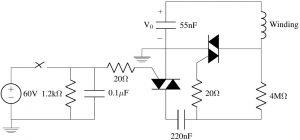Electrical Qualification of Form-Wound Air-Core Armature Windings for High Speed Electrical Machines
Jackson Lenz with Advisor Professor Kiruba S. Haran
To ensure that armature windings can withstand the intense electrical conditions presented by a high voltage, high frequency, drive, they must be electrically qualified to prevent turn-to-turn, phase-to-phase, and phase-to-ground shorts. Specialty impulse winding test (IWT) hardware is used to accurately qualify the turn-turn insulation of low resistance, low inductance air-core armature windings. Figure 5 shows the circuit developed to perform the test.
The principle of the IWT is to present the winding with a voltage impulse that is at least twice as large as will be seen in the actual machine. This ensures functionality without damaging the winding.

Figure 6: A reference waveform, a waveform obtained from a healthy winding, and a waveform obtained from a damaged winding
Example test waveforms showing a reference waveform, a waveform obtained from a healthy winding, and a waveform obtained from a damaged winding are presented in Figure 6. This research is supported by the Grainger Center of Electric Machinery and Electromechanics and NASA.
